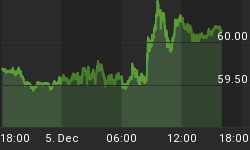A wise acquaintance of mine, Clyde Harrison, is fond of saying that fiat currencies do not float; they just sink at different rates. How can all fiat currencies sink? If dollar is appreciating vs. the euro, the euro is sinking, but the dollar is floating higher, isn't it? Yes, it is floating higher vs. the euro, but they both might be sinking. How's that? Consider what has been happening of late to the price of gold - both in dollar and euro terms. Today, the euro price of gold hit its highest level since the inception of the euro of 356 euros per ounce of gold. Well, that's to be expected, isn't it, given that the euro has been depreciating against the dollar? And, wouldn't we then expect that the price of gold in dollar terms would be falling? That's what is suggested by the data in Chart 1. In the past 15 years, there has been a large negative correlation, minus 0.78, between the value of the dollar vs. the euro and the dollar price of gold. As the dollar rose against the euro, the dollar price of gold tended to fall.
Chart 1
Now, a couple of weeks do not define a trend reversal, but it is interesting that of late, the dollar has been rising against the euro and so, too, has the dollar price of gold (see Chart 2). In other words, both the euro and the dollar are sinking - sinking against the dollar. Could it be that global investors are becoming disenchanted with fiat currencies of all stripes?
Chart 2
















